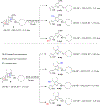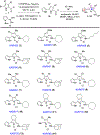Tambjamines as Fast-Acting Multistage Antimalarials
- PMID: 39526703
- PMCID: PMC11645189
- DOI: 10.1021/acsinfecdis.4c00659
Tambjamines as Fast-Acting Multistage Antimalarials
Abstract
Well-tolerated and novel antimalarials that can combat multiple stages of the parasite life cycle are desirable but challenging to discover and develop. Herein, we report results for natural product-inspired novel tambjamine antimalarials. We show that they are potent against liver, asexual erythrocytic, and sexual erythrocytic parasite life cycle stages. Notably, our lead candidate 1 (KAR425) displays excellent oral efficacy with complete clearance of parasites within 72 h of treatment in the humanized Plasmodium falciparum (NOD-scid) mouse model at 50 mg/kg × 4 days. Profiling of compound 1 demonstrated a fast in vitro killing profile. In addition, several other tambjamine analogues cured erythrocytic Plasmodium yoelii infections after oral doses of 30 and 50 mg/kg × 4 days in a murine model while exhibiting good safety and metabolic profiles. This study presents the first account of multiple-stage antiplasmodial activities with rapid killing profile in the tambjamine family.
Keywords: antimalarials; antiplasmodial; fast-acting; multistage; natural products; tambjamines.
Conflict of interest statement
The authors declare no competing financial interest.
The material has been reviewed by the Walter Reed Army Institute of Research (WRAIR). There is no objection to its presentation and/or publication. The opinions or assertions contained herein are the private views of the authors and are not to be constructed as official or as reflecting the true views of the Department of the Army or the Department of Defense.
Figures






References
-
- World Health Organization. World Malaria Report; WHO: Geneva, Switzerland, 2023.
-
- Arya A; Kojom Foko LP; Chaudhry S; Sharma A; Singh V Artemisinin-based combination therapy (ACT) and drug resistance molecular markers: A systematic review of clinical studies from two malaria endemic regions-India and sub-Saharan Africa. Int. J. Parasitol. Drugs Drug Resist 2021, 15, 43–56. - PMC - PubMed
-
- Uwimana A; Legrand E; Stokes BH; Ndikumana JM; Warsame M; Umulisa N; Ngamije D; Munyaneza T; Mazarati JB; Munguti K; Campagne P; Criscuolo A; Ariey F; Murindahabi M; Ringwald P; Fidock DA; Mbituyumuremyi A; Menard D Emergence and clonal expansion of in vitro artemisinin-resistant Plasmodium falciparum kelch13 R561H mutant parasites in Rwanda. Nat. Med 2020, 26, 1602–1608. - PMC - PubMed
-
- Rosenthal PJ; Asua V; Conrad MD Emergence, transmission dynamics and mechanisms of artemisinin partial resistance in malaria parasites in Africa. Nat. Rev. Microbiol 2024, 22, 373–384. - PubMed

